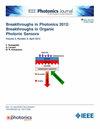通过原位训练实现相位编码的可重构集成光子单元神经网络
IF 2.1
4区 工程技术
Q3 ENGINEERING, ELECTRICAL & ELECTRONIC
引用次数: 0
摘要
光子神经网络正在成为人工智能(AI)领域前景广阔的计算平台。特别是,集成光子单元神经网络(IPUNN)能够在构建更深层次的神经网络时缓解梯度消失/爆炸问题。此外,与非单元神经网络相比,它们的光学实现也要简单得多。同时,实值数据集仍是人工智能研究的主流,而编码策略对 IPUNN 的性能至关重要。然而,很少有研究比较 IPUNNs 表示这些实值数据集的不同编码策略及其对 IPUNNs 性能的影响。在此,针对实值特征的编码策略,我们首先通过数值模拟,以决策边界和图像识别任务为基准,比较了相位编码、振幅编码和混合编码等不同方案。在相同的基准下,我们还将 IPUNN 的这些编码策略与具有可训练偏差的非单元实值神经网络 (RVNN) 进行了比较。结果表明,相位编码优于振幅编码和混合编码,其性能与非单元实值神经网络相当。为了验证数值结果,设计并制造了一个 10×10 IPUNN 芯片。由于相位编码在数值研究中表现出色,因此我们选择了相位编码。我们重新配置了 IPUNN 芯片,通过片上原位训练来执行决策边界和图像识别任务。实验结果与模拟结果非常吻合。我们的工作为在人工智能计算中实现可重构 IPUNN 提供了启示。本文章由计算机程序翻译,如有差异,请以英文原文为准。
Reconfigurable Integrated Photonic Unitary Neural Networks With Phase Encoding Enabled by In-Situ Training
Photonic neural networks are emerging as promising computing platforms for artificial intelligence (AI). Particularly, integrated photonic unitary neural networks (IPUNNs) are capable of mitigating gradient vanishing/explosion problems when deeper neural networks are constructed. Furthermore, their optical implementations are also much simpler compared to non-unitary counterparts. Meanwhile, real-valued datasets still dominate AI research and the encoding strategy is critical for IPUNNs' performances. However, there are few studies to compare different encoding strategies of IPUNNs to represent these real-valued datasets and their impacts on IPUNNs' performances. Here, in the scope of encoding strategies for real-valued features, we first compare different schemes, such as phase, amplitude and hybrid encoding using numerical simulations, with benchmarks of decision boundary and image recognition tasks. These encoding strategies of IPUNNs are also compared to non-unitary real-valued neural networks (RVNNs) with trainable biases for the same benchmarks. The results suggest that phase encoding outperforms amplitude and hybrid encoding, and exhibits comparable performances to non-unitary RVNNs. To verify the numerical results, a 10×10 IPUNN chip is designed and fabricated. The phase encoding is chosen to be implemented because of its superior performances in numerical studies. We reconfigure the IPUNN chip to perform decision boundary and image recognition tasks by on-chip in-situ training. The experimental results match the simulations well. Our work provides insights for implementing reconfigurable IPUNNs in AI computing.
求助全文
通过发布文献求助,成功后即可免费获取论文全文。
去求助
来源期刊

IEEE Photonics Journal
ENGINEERING, ELECTRICAL & ELECTRONIC-OPTICS
CiteScore
4.50
自引率
8.30%
发文量
489
审稿时长
1.4 months
期刊介绍:
Breakthroughs in the generation of light and in its control and utilization have given rise to the field of Photonics, a rapidly expanding area of science and technology with major technological and economic impact. Photonics integrates quantum electronics and optics to accelerate progress in the generation of novel photon sources and in their utilization in emerging applications at the micro and nano scales spanning from the far-infrared/THz to the x-ray region of the electromagnetic spectrum. IEEE Photonics Journal is an online-only journal dedicated to the rapid disclosure of top-quality peer-reviewed research at the forefront of all areas of photonics. Contributions addressing issues ranging from fundamental understanding to emerging technologies and applications are within the scope of the Journal. The Journal includes topics in: Photon sources from far infrared to X-rays, Photonics materials and engineered photonic structures, Integrated optics and optoelectronic, Ultrafast, attosecond, high field and short wavelength photonics, Biophotonics, including DNA photonics, Nanophotonics, Magnetophotonics, Fundamentals of light propagation and interaction; nonlinear effects, Optical data storage, Fiber optics and optical communications devices, systems, and technologies, Micro Opto Electro Mechanical Systems (MOEMS), Microwave photonics, Optical Sensors.
 求助内容:
求助内容: 应助结果提醒方式:
应助结果提醒方式:


